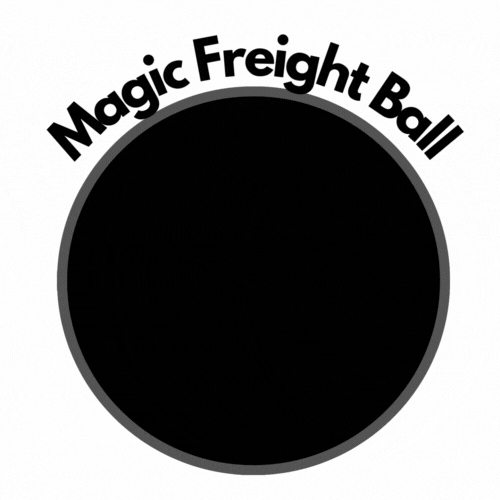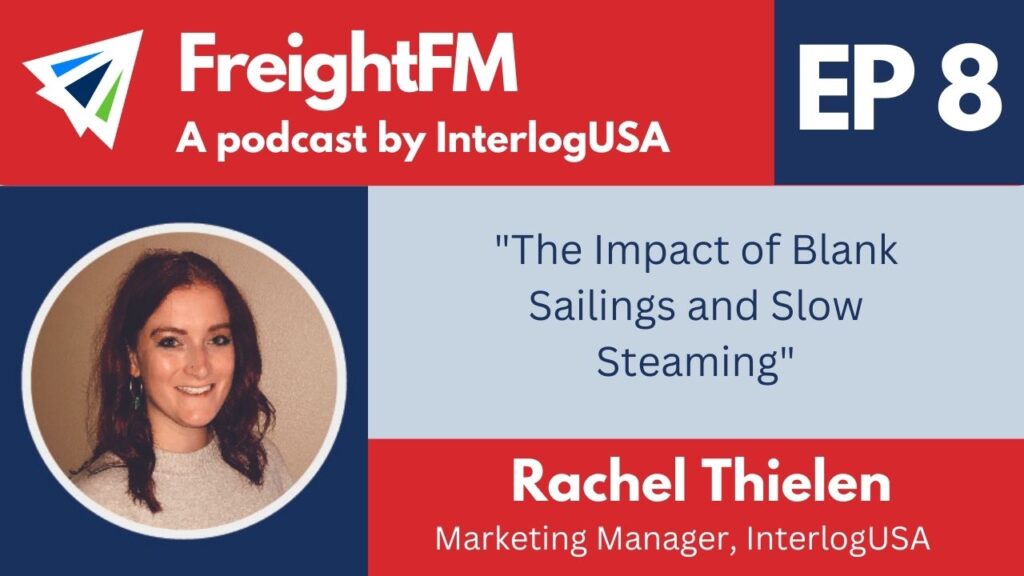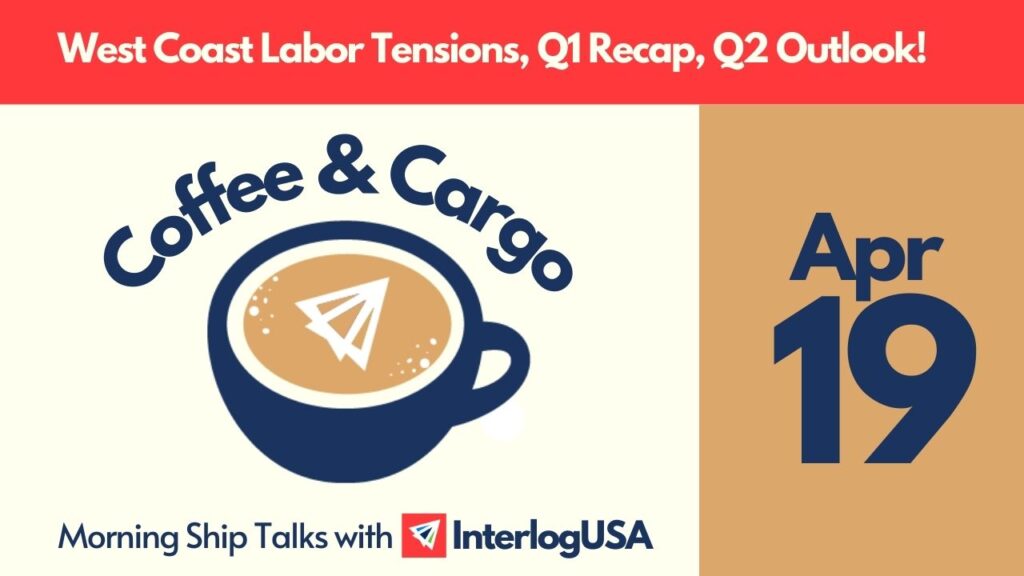Interlog  Insights
Insights
April 2023
The following is an archived collection of our weekly insights through the fourth month of 2023. Those who had signed up to our Interlog Insights newsletter received each week’s update to their inbox on the original release date. If you like what you see below, please feel free to sign up yourself to get these updates right as they come!
This month's insights
- "Magic Freight Ball"
- Cleans Trucks Act
- Market Outlook
- West Coast Labor Contract
- Detention and Demurrage
Week 4 - Originally released April 28
Recap: Takeaways from April's Insights
Schedule reliability Scheduling continues to improve, back to where it was around the pandemic started. Furthermore, the average delay for late vessel arrivals continues to decreases, closing in at 2019 levels. Complexities with detention and demurrage How ocean carriers and marine terminals assess detention and demurrage fees continues to be a hot topic in freight news. The deadline for the Federal Maritime Commission to address detention and demurrage fees within one year is fast approaching. Several container lines like Maersk and HMM announced in past weeks they stopped charging importers/consignee’s demurrage fees on days when terminals close. If the FMC finalizes rules that require terminals to bill shippers directly, that could add a new level of difficulties. Some terminals are concerned that the fee structure that incentivizes cargo movement will be hindered even more, and could cause an increase in supply chain congestion at U.S. ports. The Clean Trucks Act in Maryland The measure has been recently passed by the General Assembly. This CTA is similar to California but reflects a more “fair compromise” highlighting trucking industry concerns. Essentially the Maryland DOE will conduct and analyze a variety of assessments, and then provide those to the General Assembly by December 1st, 2024. Maryland would be able to potentially delay implementation, if the results of the assessment are determined to be too difficult to make work. |
NEW Episode: Strategies carriers are deploying in the market
Interlog’s Marketing Manager Rachel Thielen covers all things market conditions. Whether that’s spot versus contract rates, carrier strategies, or slow steaming. Listen to what she has to say in the newest episode of FreightFM!
Week 3 - Originally released April 21
Insight: "Tentative agreement" on "certain key" issues reached on the West Coast?
Remember last week when we said the wildcard for 2023 was the uncertainty revolving around the West Coast and its nearly yearlong contract negotiations? Even though the industry is up against other issues, like gluttonous inventories and carrier desperation, a new contract, or lack thereof, remains the top concern in international shipping as no one appears to have a firm understanding on when the two parties will shake hands. Well, there’s finally some news. Yesterday, the International Longshore and Warehouse Union (ILWU), the representative party for WC dockworkers, announced that it had reached a “tentative agreement” on “certain key issues” with the Pacific Maritime Association (PMA), representing WC employers. The two parties have been at an impasse since negotiations began May 10, last year. Last summer, the previous contract expired, which has left some 22,000 dockworkers without a deal for the past several months. This is the first time in months that the public has received some sort of update from either party on the status of ongoing talks and it’s positive. “Certain key issues” sounds like they finally met halfway on problems, like robots, that they have been at odds with. The only debate left is what color pen should be used to sign the new and awesome contact. The West Coast is just a couple days out from a final deal that will bring peace and cargo back to key ports, like Seattle, Los Angeles, and Long Beach. Why doesn’t this announcement add up? None of that’s true. It doesn’t add up and here’s why. Wasn’t a joint statement Yesterday’s statement came only from the desk of ILWU. The PMA had no part in what was released to the press. The union’s public announcement also vastly differs from previous statements made over the past year, which were jointly released with the PMA. Announcement came right as confirmation hearing for new labor secretary began yesterday There’s no official labor secretary, right now. The previous one, Marty Walsh, left for ice hockey in February. However, his hopeful replacement, Julie Su, appeared yesterday as the Biden administration’s nominee to be the country’s next Secretary of Labor. Su, who has been acting labor secretary since Walsh’s resignation, has been in frequent contact already with the West Coast. Port of Los Angeles Executive Director Gene Seroka praised her for being “on the phone with us morning, noon, and night”. The position serves as an envoy between the White House and the West Coast. Like many shippers are urging, the government may intervene and apply some pressure on the stalling talks. ILWU’s decision to release this promising statement ahead of Su’s hearing could be strategic as the nominee is seen as a pro-labor pick—a favorable selection for the union. The word “tentative” Tentative. When’s the last time you heard that word and something actually went to plan? Think about how many dates, parties, or other events were ultimately cancelled once that word was placed in front of them. Dating life aside, apply tentative to logistics. Last year, the rail industry saw the true meaning of what this word often spells out. Back in September, rail unions and freight railroads tentatively agreed to a new labor contract. At the time, everyone believed a deal was reached as what lay ahead appeared to be simple formalities. Flash forward three months later to December. The tentative deal still hadn’t closed. The government ultimately had to step in and forcibly forge an agreement—a result that neither party desired. Actions speak louder than words ILWU’s announcement does not pair well with recent job-related actions that forced operations to shut down at the ports of Los Angeles and Long Beach. Union dockworkers failed to show up for shifts on a back-to-back night and day shift. Ironically, this is first direct disruption at the southern Californian ports since the talks began last May, however that doesn’t dismiss its timing—a couple weeks before this promising announcement. Final Thoughts Of course, these are observations. While we believe there’s more progress left to be made than what this announcement suggests, maybe the two parties have brilliantly turned the corner. Maybe by the time this newsletter is found in spam folders on Monday, a new West Coast contract will be met. As always, InterlogUSA will continue to monitor the situation closely and provide updates when they come. |

UPDATE Magic Freight Ball
April 15’s general rate increase (GRI) has stuck to around $500 per 40’/40’HC. However, some carriers have held off implementing until April 30.
Another round of GRIs is expected to hit in May, with some carriers imposing them as early as May 1. There have been talks increases could be as high as $1000-$1125 per 40’/40’HC .
We are keeping a close eye on upcoming GRIs and will keep sending updates. If you have any questions or want to discuss options with our team, please reach out to us!
Insight: Maryland's Clean Trucks Act versus California's
Officials in the trucking industry understand that zero-emission vehicle trucks are coming but emphasized that Maryland has made a well-advised decision not to just adopt the Clean Trucks Act without first consulting with some of those in the industry. Essentially Maryland took California’s legislation on the CTA and made it into a more “fair compromise” after working with Volvo Trucks, an equipment manufacturers association, and the Maryland Automobile Dealers Association. After many bill readings, motions, amendments and votes in both chambers, they finally reached a final passage. The Maryland Department of Environment has to adopt the Clean Trucks Act as a regulation by December 1. But the Maryland DOE has to conduct a thorough needs assessment with input from several state agencies: Maryland’s energy administration; departments of transportation and general services; public services; and public service commission. The assessment must look into key factors, like electrical capacity, transmission distribution demands, and hydrogen fueling output. Furthermore, the economic feasibility and available vehicle models for the clean vehicle transition for medium and heavy duty vehicles in the state vehicle fleet must be considered. Additionally, this legislation would increase grants for qualified medium-duty or heavy-duty zero-emission trucks. Then, after analyzing its needs assessment, the Maryland DOT has to provide those reports to the General Assembly by December 1, 2024. “Since this doesn’t take effect until the 2027 model year, we will have data from California, New York and other earlier adopters to see if they have been able to hit the targets in the ACT,” Louis Campion, President and CEO of Maryland Motor Truck Association said. Maryland would be authorized to potentially delay implementation if the needs assessment determines it is infeasible to proceed. |
Week 2 – Originally released April 14
Insight: The Complexities of Invoicing Demurrage and Detention
When the Ocean Shipping Reform Act (OSRA-22) passed in 2022, it stated that the FMC must address the billing of detention and demurrage fees within one year. That deadline is fast approaching.
The FMC has two months (until June) to issue its ruling on this issue. The issue being how ocean carriers and marine terminals assess fees to importers for containers that dwell at port yards beyond contractual free time.
With the rule looming, several container lines (HMM, Maersk, etc.) have announced they have stopped charging importers or consignees, demurrages fees on days when terminals are closed.
However, uncertainty remains because from the perspective of marine terminal operators, storage fees will accumulate whether or not a terminal’s gates are open to truckers or not.
Want more on the West Coast? Watch April’s installment of our monthly webinar series “Coffee & Cargo”. This month, our experts also discussed Q1 and Q2 for international shipping in front of our LIVE audience. Watch it anytime!
Insight: The Second Half of 2023 - Will Flowers Bloom after 1H Showers?
We opened up the month of April with the classic adage, “April showers bring May flowers”, and applied this to 2023 outlook for international shipping.
Admittedly, last week’s edition was gloomy as we covered the “showers” of the first half of 2023.
From bloated inventories and low demand to stalling labor negotiations and carrier aggression, the showers, if you will, have been torrential so far in the year.
In reality, torrential rain does not help flowers grow—it just washes them away. So, while this weakens the metaphor we’ve rolled with, we are pleased to forecast a stronger second half of 2023 despite a concerning first half. Flowers are going to grow after all.
Inventories are steadily clearing, a restock will soon be in order
2022 was chaotic. It took us until late last year to finally ascertain when its peak season actually was—late spring and early summer.
Since then, retailers have had the order blues as everything was mistimed. A lot of shippers remained sitting on massive inventories going into 2023.
However, as we trudge along into Q2 these fatty deposits of goods are now slimming.
Of course, inventory is finite. It was never a question of if, but when.
And, even though one can grow cynical when there’s a demand dark age, it’s inherently true that overordering was never the end of the world.
With inventory levels receding, we’ve snapped back to the reality that a restock will be due soon.
All of the sudden, there’s less focus on what happened in 2022 and more focus on what will be done to prepare for the latter end of 2023.
In preparation for the holiday season, we can expect a stronger outlook for freight volumes in the second half of the year. In fact, we can expect a traditional peak season in the sense that its timing will fall around August and September, much like pre-pandemic times.
However, unlike shipping in the Covid-era or even pre-pandemic era, peak season won’t be a hectic surge in freight activity. Rather, we predict it’ll be much more spread out and, frankly, smarter.
Please, pat yourself on the back. Shippers are a lot more strategic when it comes to their logistics processes now.
2021 and 2022 gave the industry more wisdom than the 2000s and 2010s combined. Every supply chain blunder that’s humanly possible happened in the last three years.
Cherry on the top would be West Coast peace
Yes, the first rule of logistics is that its everchanging. That said, we are still tethered to our forecasts of volumes resurrecting in the second half.
However, what we can’t confidently wrap our forecast around are the ongoing labor talks out on the West Coast.
The dockworker union and West Coast maritime employers have been at the negotiating table for nearly a year. Talks began May 10, the previous contract expired July 1, and it’s been at an impasse ever since.
Updates have been minimal as active negotiations are closed off to the media.
There’s mounting pressure from shippers to get the government involved. However, besides former Labor Secretary Marty Walsh, who has since left to head a hockey players union, paying a few visits, there hasn’t been much publicized intervention.
Meanwhile, the impacts have been noticeable. The West Coast has lost a fair deal of discretionary cargo as shippers continue to avert its ports for the East and Gulf coasts.
With the talks dragging on, the temperature appears to have risen as well in the negotiating room. Job-related actions by union-represented dockworkers have been more prominent in the last few weeks.
Last week on Thursday night through Friday, all container terminals at Long Beach and Los Angeles had to shut down completely.
If more mischief like this continues, the West Coast will have its own story in 2023, one that’s separate from its East and Gulf coasts counterparts.
Week 1 – Originally released April 7
Insight: The First Half of 2023 - Will Its Showers Give Way to 2H Flowers?
April showers bring May flowers. Sure, if it wasn’t the start of April we wouldn’t be using this phrase, but it’s also not a reach when it comes to describing everyone’s forecast of international shipping. First-half of the year showers bring second-half of the year flowers? How does that sound? Whether it sounds like a good metaphor to you or not, whatever. We’re rolling with it. The showers have been torrential through Q1 and are set to dampen Q2. The main culprits have been low freight volumes, bloated inventories, carrier aggression, and a lack of progress in West Coast labor talks. Low freight volumes, overstocked inventories Many shippers have held off on ordering due to overstocking last year. As a result, February had the lowest inbound volumes since May 2020 while container rates from China to the US dipped to pre-pandemic levels. Carrier aggression Meanwhile, carriers reached the point they long feared—a cooldown in demand. While everyone knew it’d happen at some point, no one predicted Pluto would be warmer than the freight freeze we’ve all felt. And, like a scared dog when backed in a corner, carriers have had to show their teeth. Transpacific schedules are peppered with blank sailings, especially to the WC, as shipping lines fight to curb excess capacity. All while doing that, they’ve also tried to fatten up lower rates by imposing general rate increases (GRIs). West Coast labor talks And, then there’s the WC labor talks. Arguably, the crescendo to anyone’s first-half of 2023 diatribe. When will an agreement be reached? How will an agreement be reached? Who will have to be involved for an agreement to be reached? These are questions that have no clear answers. The uncertainty is numbing. It’s not the first saga these talks have ever seen, but it’s nearing a year since WC dockworkers and maritime employers began negotiations for this time around. Between their start in early May to now, the WC has lost its typical vice grip on America’s eastbound import share with discretionary cargo being rerouted to the East and Gulf coasts. If any of these issues we listed would continue into the second half of 2023, our best bet would be these contact talks. Stay tuned for more optimism Admittedly, this was a rather gloomy contribution to our weekly newsletter. However, we are expecting “flowers” for the second half of 2023 and things will give way to a much stronger state for international shipping. Next week, we will go over what we can expect to see in the industry in the latter half of the year. |
Insight: Schedule Reliability for the Container Shipping Industry has Increased
The container shipping industry is redeeming its schedule reliability, back to where it was at pre-pandemic. “Schedule reliability was a staggering 26 percentage points higher” year-over-year, Alan Murphy, the CEO of Sea-Intelligence reports. The 14 major carriers all averaged 57 percent schedule reliability, up from just 29 percent back in February 2022. Additionally the average delay for late vessel arrivals has decreased. Murphy noted in his reports that the average delay for late vessel arrivals is now closer to the 2019 level than the high 2021-2022 levels. From the decreasing volume coming into and out of the ports, plus the increasing number of blank sailings in 2023, some pressure has eased on the container lines and ports. Thus, this has allowed them to decrease backlogs, get rid of the surge of containers and the pile up of empty containers. |
NEW Episode: Strikes in Western Europe leads to disruptions
Listen to Interlog’s Project Manager Emily Smith discuss recent labor-related tensions in Germany and France on the lastest episode of FreightFM!
What did you think?
In addition, please email us at sales@interlogusa.com with any news or topics you’d like our experts to cover in future issues!


